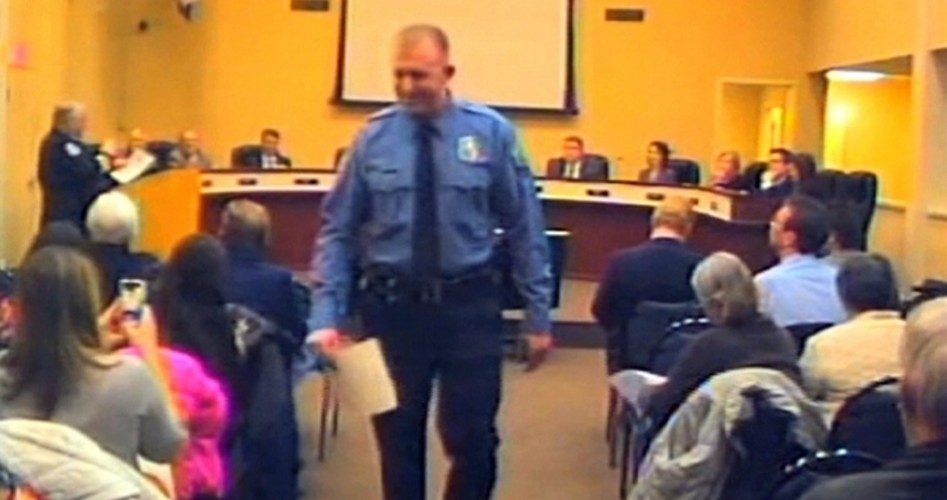
Additional information has been reported in the last couple of days that, if accurate, may exonerate Darren Wilson (shown), a white Ferguson, Missouri, police officer, from claims repeated by the national media that he shot Michael Brown, an innocent, unarmed, 18-year-old black man, while Brown was running away from him.
Christine Byers, a reporter from the St. Louis Post-Dispatch, tweeted on Monday, August 18, “Police sources tell me more than a dozen witnesses have corroborated cop’s version of events in shooting #Ferguson.”
Jim Hoft, blogging at Gateway Pundit the next day, claimed that Wilson suffered an “orbital blowout fracture to the eye socket” as a result of his confrontation with Brown. Hoft claimed that his information came from “a source within the Prosecuting Attorney’s office and confirmed by the St. Louis County Police.” He explained that an orbital blowout fracture “is a fracture of one or more of the bones surrounding the eye.” Then, on Wednesday, Fox News reported on this information from a “well-placed source” in the St. Louis County Police Department.
Then of course there were the autopsy results from Sunday showing that the shots that hit Brown were in the front of his body.
These revelations came on top of a call received by Dana Loesch on her radio show last Friday from someone named Josie, who claimed to be a friend of Wilson’s and who told her what happened. She said:
And then Michael just bumrushes him [Wilson] and pushes him back into his car. Punches him in the face and then Darren grabs for his gun. Michael grabbed for the gun. At one point he got the gun entirely turned against his hip. And he shoves it away. And the gun goes off.
Well, then Michael takes off and gets to be about 35 feet away. And, Darren’s first protocol is to pursue. So, he stands up and yells, “Freeze!” Michael and his friend turn around.
And Michael taunts him….
And then all of a sudden he [Brown] just started bumrushing him [Wilson]. He just started coming at him full speed. And so he [Wilson] just started shooting. And he [Brown] just kept coming. And so he [Wilson] thinks he [Brown] was on something.
The final shot was in the forehead, and then he [Brown] fell about two or three feet in front of the officer.
If the above accounts prove to be true, then Wilson would be exonerated.
Questions in the case include:
• Did Brown in fact attack Wilson after Wilson asked him and his friend to walk on the sidewalk to avoid blocking traffic by walking down the middle of the street?
• Did Brown strike Wilson in the face with such force as to break bones around his eye?
• Did Wilson try to unholster his weapon to defend himself in that attack?
• Did Brown try to wrest Wilson’s sidearm away from him in that attack?
• Did Brown leave the scene briefly and then, when challenged by Wilson’s command to “freeze,” turn back to resume the attack?
• Was Brown at this moment was less than 21 feet away? (If yes, the Tueller drills that Wilson had engaged in while training during his six years as an officer would have kicked in.)
• Was Brown influenced by three substances in his system — adrenalin, testosterone, and THC (Tetrahydrocannabinal, the principal psychoactive constituent of the cannabis plant) — causing him to turn and challenge the officer he had just attacked moments earlier?
• Was Brown, being 18, feeling immortal and invincible?
• Did Brown feel offended and angry at being ordered to freeze by Wilson?
If the above are proven to be true, then Brown himself became a deadly weapon, and Wilson had less than two seconds to defend himself.
Twenty years ago, Sergeant Dennis Tueller of the Salt Lake City Police Department discovered that an assailant 21 feet away from his intended victim could cover the distance between them in less than two seconds. The Tueller drill became part of standard training protocol for officers. As Dr. Bill Lewinski of the Force Science Research Center at Minnesota State University-Mankato explained, “Within a 21-foot perimeter, most officers dealing with most [assailants] are at a decided — perhaps fatal — disadvantage if the suspect launches a sudden charge intent on harming them.”
Given sufficient training, Wilson, under circumstances described by Josie, would have reverted to his automatic response, determined that he was in danger of serious bodily injury or death, and fired his sidearm to defend himself.
The biggest question of all, should Wilson be indicted, is whether the jury of his peers will take into consideration the Supreme Court’s landmark ruling in Graham v. Connor in which the court established that “an objective reasonableness standard” should apply in cases such as the current one unfolding in Ferguson. In other words, the jury (if there be one) would have to decide if Wilson behaved, in those two seconds, as any other reasonable officer would have behaved.
Photo from video of officer Darren Wilson at a Feb. 11 city council meeting: AP Images
A graduate of Cornell University and a former investment advisor, Bob is a regular contributor to The New American magazine and blogs frequently at www.LightFromTheRight.com, primarily on economics and politics.



